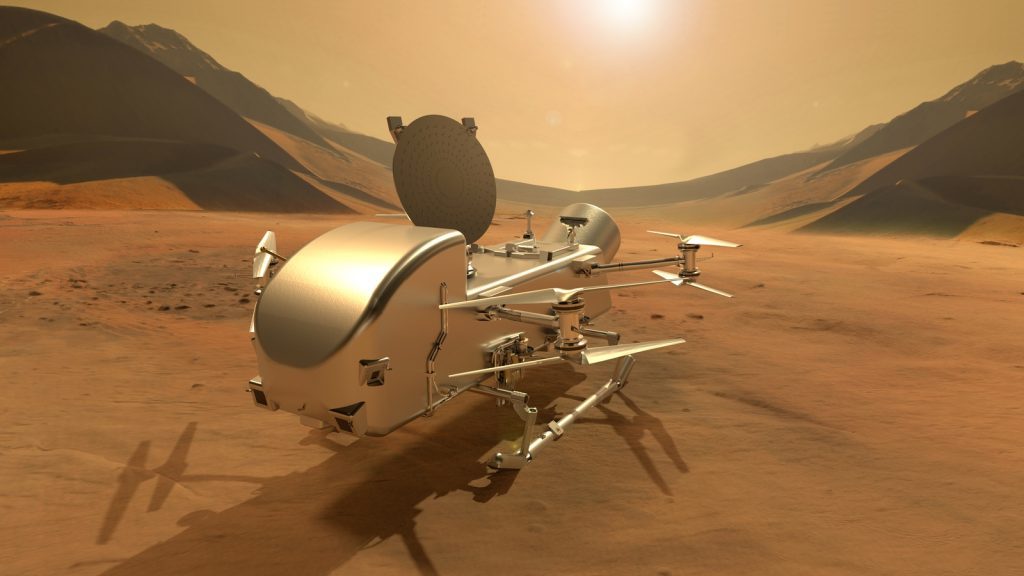WASHINGTON — NASA has given the green light to proceed with a mission to Saturn’s moon Titan even though the cost has increased by twofold since the agency chose the mission almost five years ago.
NASA announced on April 16 that the Dragonfly mission had successfully passed its confirmation review, allowing the nuclear-powered rotorcraft to proceed into full-scale development. Dragonfly will explore different areas on Titan to study its potential to support life.
The mission had started its confirmation review process last fall, but in November, the agency said it would postpone making a final decision on the mission until the spring, following the release of the fiscal year 2025 budget proposal. NASA also revealed that the mission's launch, initially set for July 2027, had been pushed back to July 2028.
The confirmation review represents NASA's official commitment to the mission's cost and schedule. NASA confirmed that Dragonfly will launch in July 2028 and that the total mission cost will be $3.35 billion.
This cost is significantly higher than the amount approved by NASA when Dragonfly was chosen as NASA's latest New Frontiers mission in June 2019. At that time, the mission was capped at $850 million for Phases A through D, excluding launch and post-launch operations.
In its confirmation announcement, NASA acknowledged that the overall cost, including launch and operations, had doubled compared to the earlier estimate. The agency attributed this increase to various factors, such as revising plans due to budget constraints, pandemic impacts, supply chain challenges, and a thorough design revision.
In a statement to SpaceNews on April 19, NASA explained that the original cap costs had risen from $1 billion in inflation-adjusted dollars to $2.1 billion, resulting in the doubled costs.
“In each of the three fiscal years after Dragonfly was selected, NASA enforced a cost limit for the current year due to budget constraints. The combined effect of these early NASA-directed revisions, as well as another one after the Preliminary Design Review (PDR), accounts for almost two thirds of the increase in Phase A-D costs,” NASA stated.
“The Dragonfly project also underwent an extensive design revision before the PDR,” NASA added. “The heightened costs of this, along with pandemic-related rises in labor expenses and the cost of components and materials, contribute to the rest of the increase in Phase A-D costs.”
These increases are evident in NASA’s fiscal year 2025 budget plan, which includes a request for $434.6 million for Dragonfly, up from a projection of $355.5 million in the agency’s 2024 budget request. From 2025 to 2028, NASA now anticipates spending $1.68 billion on Dragonfly, double the projected amount in its 2024 proposal.
NASA also expects higher expenditure for Dragonfly’s launch. NASA plans to obtain a heavy-lift launch vehicle for the mission later this year to enable Dragonfly to reach Titan by 2034. This is the original target date set when NASA chose the mission in 2019, despite a two-year delay in its launch since then.
The organization still supports the mission even though there are challenges with the cost. Nicola Fox, an associate administrator at NASA, said that they are thrilled to move forward with the Dragonfly mission, which is a fascinating science mission that many people are interested in. She added that exploring Titan will push the boundaries of what we can do with rotorcraft outside of Earth.
The increase in costs, along with overall budget pressures on NASA and its planetary science programs, will have an impact on future programs. Dragonfly is the fourth mission in the New Frontiers line, following New Horizons, Juno, and OSIRIS-REx. NASA had planned to announce a call for proposals for the fifth New Frontiers mission in 2023. However, the release of this announcement has been delayed and is now expected no earlier than 2026..
The agency has also indicated that there may be delays in calls for future missions in the Discovery line of planetary science missions, which have lower cost caps than New Frontiers, as well as a line of planetary smallsat missions called SIMPLEx. Lori Glaze, director of NASA’s planetary science division, stated that there are limited options to address these short-term budget challenges when it comes to calling for mission proposals.
The constraints on the budget have also impacted NASA’s ability to start work on a future flagship planetary science mission, specifically a Uranus orbiter and atmospheric probe that was recommended by the most recent planetary science decadal survey.
Due to the current budget situation, NASA is unable to begin the necessary studies and activities to commence work on the mission, as mentioned by Glaze at the town hall meeting. NASA had hoped to start work on that either this year or next year, but the current funding situation does not seem to support it.









